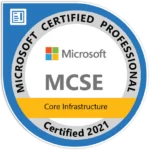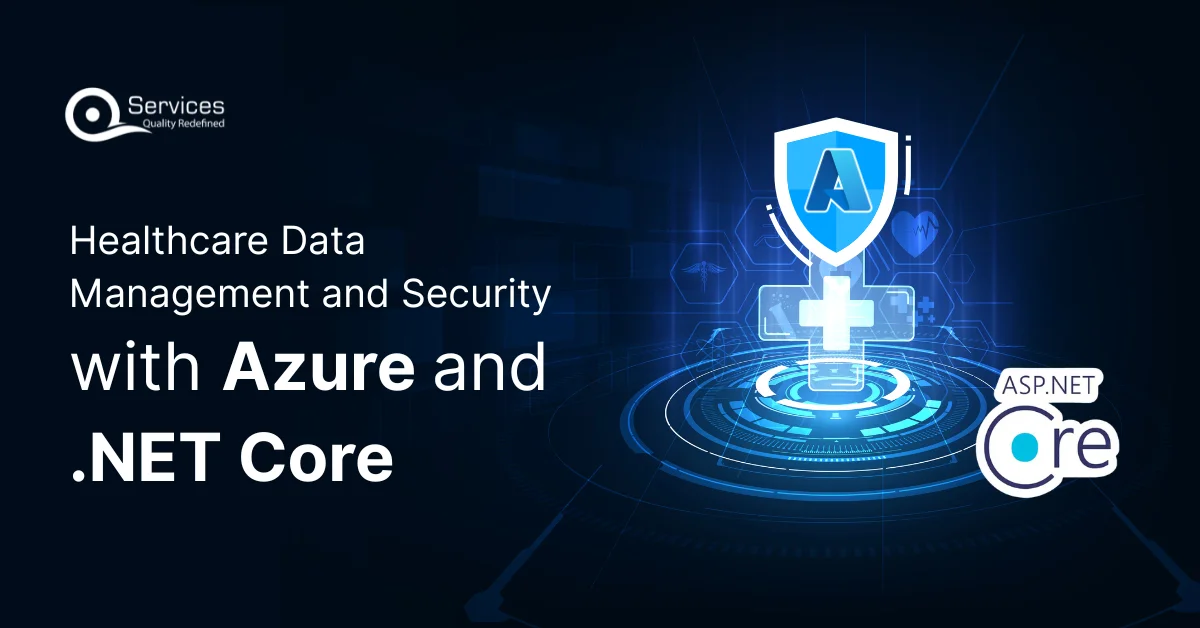
Rewards
.





CANADA
55 Village Center Place, Suite 307 Bldg 4287,
Mississauga ON L4Z 1V9, Canada
Certified Members:
.



Home » Understanding Azure Kubernetes Service for Beginners

The rise of containerized applications has strongly changed the scenario of application deployment. Out of several platforms, Kubernetes emerged because of its robust features for managing containerized workloads, However, its intimidating nature created challenges for organizations in terms of managing and scaling.
Later on, the development of container orchestration tools like Azure Kubernetes Service (AKS) and Docker Swarm simplified the deployment while reducing operational overhead. These tools helped organizations in handling critical infrastructure tasks while giving full control over their containerized applications. Let’s explore how this combination of automation and control can lead to modern application deployment.
Azure Kubernetes Service (AKS) is a fully managed Kubernetes service that helps in managing and deploying containerized applications. Compared to Kubernetes, AKS provides simple and easy ways to maintain and manage complex clusters. It handles critical tasks like health monitoring, load balancing, and automatic updates of the Kubernetes control plane. AKS also integrates seamlessly with other Azure services, providing enhanced security, monitoring, and networking capabilities.
An app, like a shopping website, is put into containers and uploaded to Azure.
AKS sets up everything needed, like the nodes and tools, to run the app smoothly.
The app’s containers are placed on the nodes. Each container handles important tasks of an app.
AKS automatically fixes critical tasks like scalability or node failure. It also handles updates, security and monitoring to make management easier.
AKS contains several useful features that makes it a top choice for developers. Here are some of its core features:
Azure completely takes care of the Kubernetes control plane for you. It handles upgrades, patches, and maintenance tasks automatically. This reduces operational overhead and saves valuable time for developers.
AKS works seamlessly with other Azure tools. It integrates with Azure Active Directory (AD) for secure access management and Azure Monitor for effective cluster monitoring. These integrations improve efficiency and reliability.
AKS supports both cluster autoscaling and pod autoscaling. This means it automatically adjusts resources to handle sudden increases in workload or traffic.
AKS provides built-in security features like role-based access control (RBAC) and network policies. You can protect your workloads and ensure only authorized users access the cluster.
AKS offers cost savings by providing a free control plane. You only pay for the worker nodes and resources your applications use.
AKS supports DevOps tools like Azure DevOps and GitHub Actions. You can build, test, and deploy applications faster with continuous integration and delivery pipelines.
Azure Container Instances (ACI) enables direct container deployment in the cloud without virtual machine management. It launches containers within seconds, maintaining common OS images for both Windows and Linux containers from Docker registries. This eliminates VM overhead and speeds up application deployment in cloud environments.
This service from Microsoft allows users to manage containerized applications using OpenShift, powered with Azure’s infrastructure. OpenShift has been preferred by several businesses due to its user-friendly interface and built-in security features, and its integration with Azure ensures smoother experience.
Azure Arc-enabled Kubernetes simplifies resource management by providing a single control plane that monitors and manages multi-cloud environments (GCP or AWS). It also enables organizations to leverage Azure’s suite of tools to any infrastructure whether on-premises or in another cloud.
Azure container apps is useful for those who are new to containers. It is a serverless platform that runs containerized applications with little or no infrastructure management. It can scale applications automatically based on the memory load and traffic.
Get free Consultation and let us know your project idea to turn into an amazing digital product.
Microsoft’s AKS is a widely used container orchestration tool, known for its ability to make deployment and management easier for containerized applications. It is a cost-effective solution for businesses of all sizes as it automates several important tasks and reduces administrative overhead.
Red Hat OpenShift is another container orchestration platform built on Kubernetes. It contains developer-focused tools and enhanced security features compared to the standard Kubernetes framework. OpenShift also includes built-in CI/CD pipelines and a web console for easier management of containerized applications.
Docker Swarm is a simpler alternative to Kubernetes for container orchestration. It integrates directly with Docker and requires minimal setup. The platform excels in smaller deployments and offers basic features like container scheduling, service discovery, and load balancing.
Amazon ECS is AWS’s container management service. It provides straightforward container orchestration that is completely integrated with Amazon Web Services. ECS offers both serverless (Fargate) and EC2-based deployment options, making it flexible for different workload requirements.
GKE is official cloud managed Kubernetes service by Google. It offers advanced features like automatic scaling, automated upgrades, and integrated logging. The service benefits from Google’s extensive experience with Kubernetes, as Google originally developed the technology.
An AKS Cluster is a group of virtual machines in Azure that runs the app’s containers. It includes nodes, pods, and the control plane, each with its own role.
(AKS) clusters require careful management to ensure optimal performance, security, and cost efficiency. Here’s a quick note on how to optimize performance in Azure Kubernetes Service clusters. Organizations must follow these practices to prevent common issues and ensure smooth operations in production environments.
Implementing proper resource requests and limits for containers is essential. Applications should specify both CPU and memory requirements to prevent resource contention. Setting appropriate quotas for namespaces helps control resource consumption and prevents any single application from consuming excessive cluster resources.
A comprehensive monitoring strategy should include both cluster-level and application-level metrics. Azure Monitor integration with AKS provides insights into container performance, node health, and resource utilization. Centralizing logs using solutions like Azure Log Analytics enables quick troubleshooting and maintains audit trails.
Regular updates of the Kubernetes version keep clusters protected against vulnerabilities. Network policies should restrict communication between pods based on defined rules. Role-Based Access Control (RBAC) implementation ensures users and applications have appropriate permissions. Container images must be scanned for vulnerabilities before deployment.
Proper configuration of cluster autoscaling helps manage varying workloads efficiently. Horizontal Pod Autoscaling should be set up based on CPU or memory metrics. Node pools should be configured with appropriate VM sizes based on workload requirements. Separate node pools for different workload types improve resource utilization.
Regular backup of cluster configuration and application state is crucial. Multiple availability zones should be used to ensure high availability. A disaster recovery plan should include procedures for cluster recovery and data restoration. Testing recovery procedures periodically ensures their effectiveness.
Reserved instances for node pools can reduce long-term costs. Proper sizing of nodes prevents resource waste. Development and testing environments should be scheduled to shut down during non-business hours. Regular monitoring of resource usage helps identify optimization opportunities.
Continuous Integration and Continuous Deployment (CI/CD) pipelines automate the process of building, testing, and deploying applications to Azure Kubernetes Service (AKS). This integration streamlines application delivery and ensures consistent deployments.
The CI/CD process begins with code stored in version control systems like GitHub or Azure DevOps. When developers commit changes, the pipeline automatically triggers. This ensures all code changes go through proper testing and deployment procedures.
The pipeline automatically builds container images from the application code. These images are then tagged with version numbers and stored in Azure Container Registry. The build process includes security scans and quality checks to maintain code standards.
Before deployment to production, the pipeline creates temporary testing environments in AKS. Automated tests verify application functionality, performance, and security. This includes unit tests, integration tests, and security scans to catch issues early.
After successful testing, the pipeline deploys the application to AKS using deployment manifests. These manifests define how the application should run in the cluster. The deployment can use strategies like rolling updates to prevent downtime.
The pipeline includes steps to verify successful deployment. It checks application health, monitors performance metrics, and ensures all services are running correctly. If issues arise, the pipeline can automatically roll back to the previous version.

Azure Kubernetes Service is helping business deploy and manage containerized applications with modern cloud solutions. It works as an enhanced version of Kubernetes operations through automation, robust security features, and access to Azure services.
AKS is designed to be a business-friendly platform that provides complete control over their apps by managing critical activities such as scalability, monitoring, and maintenance. The platform offers a variety of deployment options and seamlessly integrates with CI/CD pipelines to ensure optimal application delivery.
Organizations can benefit from AKS’s cost-effective approach, as they only pay for the computing resources they use. With features like automatic scaling, disaster recovery, and comprehensive monitoring, AKS provides a reliable foundation for modern application deployment. Its integration with other Azure services and support for different container solutions makes it a versatile choice for businesses of all sizes.

In the healthcare industry, managing and securing sensitive patient data is paramount. With the increasing adoption of cloud technologies, healthcare organizations are leveraging platforms like Microsoft Azure to store, process, and analyse healthcare data. However, with this shift comes the responsibility

The combination of Microsoft AI, Azure Health Insights, and Azure Cognitive Services is transforming healthcare by allowing smarter and efficient decision-making based on data. These technologies can fundamentally change the conventional practices of healthcare by taking new approaches to enhance

Healthcare is undergoing a massive shift thanks to new technologies. Think cloud computing, artificial intelligence (AI), and the tools developers use to build websites and apps. Hospitals and doctors’ offices are all trying to get better at caring for patients, running more smoothly, and keeping data safe. That’s why using Microsoft tech and Angular together has become a popular way to build modern, easy-to-use digital healthcare solutions.
Azure Communication Services (ACS) is a cloud-based platform by Microsoft that enables developers to add communication features—such as voice, video, chat, SMS, and email—into their applications. It provides APIs and SDKs that simplify the process of integrating these services into web and mobile apps.
Absolutely! ACS can integrate with popular tools like CRM software and helpdesk systems through APIs and SDKs. This allows your team to have all customer details and communication history in one place.
Integrating ACS into your app enhances user interaction and engagement. It improves customer support by enabling real-time communication and provides an interactive experience that can make your app stand out. It helps businesses stay connected with users via chat, calls, or notifications.
When a VideoStreamRendererView or its parent VideoStreamRenderer is no longer needed, you should properly dispose of it to free up system resources and prevent memory leaks.
Yes, ACS supports voice and video calling, making it ideal for virtual meetings, webinars, or consultations. You can use ACS to enable face-to-face or audio-only meetings in your application.
To ensure high-quality calls, implement quality monitoring and respond to diagnostic events. Handling issues like latency, packet loss, and jitter will help maintain smooth communication.
Benefits of ACS include enhanced customer engagement, improved collaboration, time and cost savings, scalability, flexibility, and robust security—all of which contribute to a better user experience and smoother app functionality.
To integrate ACS with a .NET app, install the ACS SDK via NuGet, initialize it with your ACS credentials, and use the provided APIs to add communication features like chat, voice, or video to your app.
For JavaScript apps, install the ACS SDK via npm, initialize it with your ACS credentials, and follow the documentation to integrate chat, SMS, voice, and video features into your application.
For Java apps, install the ACS SDK via Maven, initialize it with your ACS credentials, and implement the necessary communication features following the integration guidelines in the official documentation.
For Swift apps, install the ACS SDK via CocoaPods, initialize it with your ACS credentials, and follow the ACS documentation to integrate communication functionalities such as chat, video, and voice calling.
Schedule a Customized Consultation. Shape Your Azure Roadmap with Expert Guidance and Strategies Tailored to Your Business Needs.
.





55 Village Center Place, Suite 307 Bldg 4287,
Mississauga ON L4Z 1V9, Canada
.




Founder and CEO

Chief Sales Officer

🎉 Thank you for your feedback! We appreciate it. 🙌